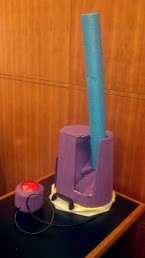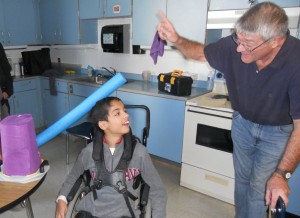Designers: Amogh Karnik, Dyuti Mahendru, Brittany Potter, Roshan Sadanani
Client Coordinator: Roger Schultz
Supervising Professor: Larry Bohs
Introduction
Students in Mr. Schultz’s classroom at Riverside High School have limited opportunities to interact due to physical and cognitive disabilities. Mr. Schultz has found that many of the students enjoy being playfully “bopped” with a foam noodle. However, the students cannot bop Mr. Schultz or each other. The goal of this project was to develop a device that allows the students to bop one another independently. The Bopper includes a control switch and an electromechanical mechanism contained in a rotating housing. When the switch is pressed, the mechanism quickly drops a foam noodle and then returns it to its vertical starting position. The Bopper is fun, easy to use, and allows students to enjoy an interactive activity.
Summary of Impact
Previously, students relied on teachers, therapists, or peer helpers to engage in any type of physical interaction in the classroom. The Bopper allows students to independently engage with their fellow students, in addition to their teachers and peer helpers. Mr. Schultz commented, “Before the bopper became available to them, [my students] could participate only in a passive way, and now the bopper project has empowered them to engage in fun interactions previously beyond their physical abilities. This project has brought a lot of fun and lively interactions to my class.”
Technical Description
The Bopper is comprised of a rotating base, a motor mechanism, a noodle mechanism, control circuitry, a control switch and a custom housing.
The rotating base is created from two pieces of 0.25” HDPE (high density polyethylene) cut in an octagonal shape and attached to a commercial Lazy Susan. Handles on the top piece make the device easy to carry and to rotate to the desired direction.
A 20 RPM DC gear motor attaches to one side of the top base piece. An offset shaft, created by attaching a 2.7x1x0.5” piece of aluminum to the motor shaft, rotates as the motor turns. A drive pin mounted parallel to the
motor shaft thereby provides an offset shaft to move the noodle mechanism.
The noodle mechanism consists of an aluminum shaft, spring, and hinge. The shaft attaches to the base using the hinge, while the spring connects between the shaft and the base. The aluminum shaft has a cross section of 0.5×1” so that the axial hole of a standard foam noodle fits snugly. An L-shaped section at the bottom of the shaft provides a lifting surface for the motor drive pin. The noodle mechanism is mounted such that as the motor rotates the drive pin, the noodle mechanism lifts until the pin clears the L-shaped section, thereby allowing the shaft to drop quickly, pulled by the force of the extended spring.
A commercial pushbutton switch is mounted in a custom housing made from PVC pipe, foam, and velvet. Pushing this “bop” switch activates a control circuit, which is powered by eight AA batteries. The circuit rotates the motor until a normally-closed switch senses that the bopper shaft is vertical. The system then rests until the user pushes the bop switch, which starts the motor rotating, disengages vertical-sense switch, initiates a bop and returns the bopper noodle to vertical.
A custom housing contains the bopper mechanism, circuitry and batteries. A 1/8” jack on the housing accepts the plug of the bop switch. Any commercial switch with a 1/8” plug can be used, allowing accommodation for students with a wide range of disabilities. The housing is covered with purple velvet, the school color.
Figure 2 shows a student using the bopper. The cost of the components for the device is approximately $240.

